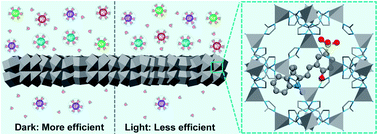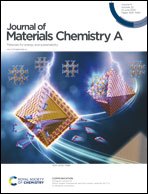Light-gated cation-selective transport in metal–organic framework membranes†
Abstract
Precise regulation of ion transport is essential for life sustainability. However, it remains a huge challenge to develop practical artificial ion-transport materials with controllable ion conduction and separation. Herein, metal–organic framework (MOF) membranes that can selectively separate Li+ from other cations and regulate Li+ conduction by light simultaneously are firstly realized by encapsulating a photochromic compound, sulfonated spiropyran (SSP), into ZIF-8 crystals. The resulting SSP@ZIF-8-10% membrane, with angstrom-sized pore windows and specific cation binding sites, exhibits a high Li+ conductivity of 1.6 × 10−4 S cm−1 and ideal selectivities of 77, 112 and 4913 for Li+/Na+, Li+/K+, and Li+/Mg2+ in the dark at 25 °C. Visible light irradiation or storing in the dark triggers isomerization of SSP between merocyanine (MC) and spiropyran (SP) forms in the SSP@ZIF-8 membranes. Consequently, the SSP@ZIF-8-10% membranes possess a large on/off ratio of 23.0 for Li+ conductivity before and after visible light irradiation, resulting from the changes of Li+ binding sites and binding affinity to SSP in the membranes. This work opens up a new avenue to develop unique MOF-based materials for efficient light-regulated Li+ ion conduction and separation in the future.



 Please wait while we load your content...
Please wait while we load your content...